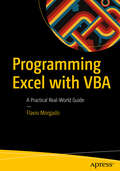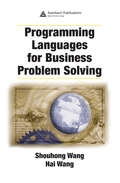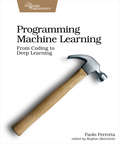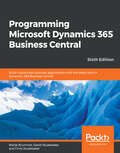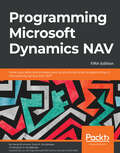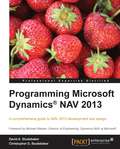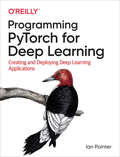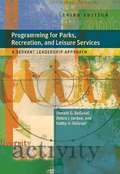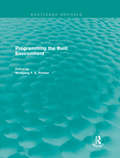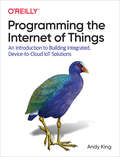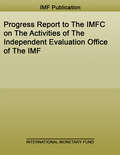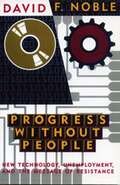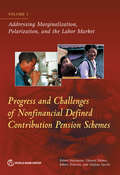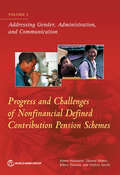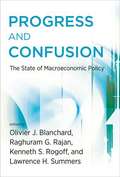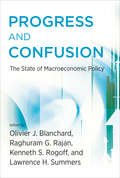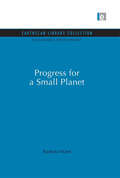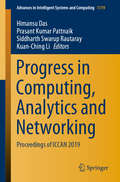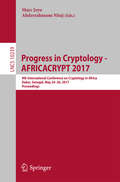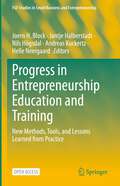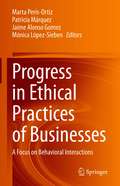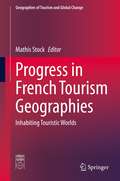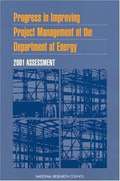- Table View
- List View
Programming Excel with VBA: A Practical Real-World Guide
by Flavio MorgadoLearn to harness the power of Visual Basic for Applications (VBA) in Microsoft Excel to develop interesting, useful, and interactive Excel applications. This book will show you how to manipulate Excel with code, allowing you to unlock extra features, accuracy, and efficiency in working with your data. Programming Excel 2016 with VBA is a complete guide to Excel application development, using step-by-step guidance, example applications, and screenshots in Excel 2016.In this book, you will learn:How to interact with key Excel objects, such as the application object, workbook object, and range objectMethods for working with ranges in detail using codeUsage of Excel as a database repositoryHow to exchange data between Excel applicationsHow to use the Windows API to expand the capabilities of ExcelA step-by-step method for producing your own custom Excel ribbonWho This Book Is For:Developers and intermediate-to-advanced Excel users who want to dive deeper into the capabilities of Excel 2016 using code.
Programming Languages for Business Problem Solving
by Shouhong Wang Hai WangIt has become crucial for managers to be computer literate in today's business environment. It is also important that those entering the field acquire the fundamental theories of information systems, the essential practical skills in computer applications, and the desire for life-long learning in information technology.Programming Languages
Programming Machine Learning: From Coding to Deep Learning
by Paolo PerrottaYou've decided to tackle machine learning - because you're job hunting, embarking on a new project, or just think self-driving cars are cool. But where to start? It's easy to be intimidated, even as a software developer. The good news is that it doesn't have to be that hard. Master machine learning by writing code one line at a time, from simple learning programs all the way to a true deep learning system. Tackle the hard topics by breaking them down so they're easier to understand, and build your confidence by getting your hands dirty. Peel away the obscurities of machine learning, starting from scratch and going all the way to deep learning. Machine learning can be intimidating, with its reliance on math and algorithms that most programmers don't encounter in their regular work. Take a hands-on approach, writing the Python code yourself, without any libraries to obscure what's really going on. Iterate on your design, and add layers of complexity as you go. Build an image recognition application from scratch with supervised learning. Predict the future with linear regression. Dive into gradient descent, a fundamental algorithm that drives most of machine learning. Create perceptrons to classify data. Build neural networks to tackle more complex and sophisticated data sets. Train and refine those networks with backpropagation and batching. Layer the neural networks, eliminate overfitting, and add convolution to transform your neural network into a true deep learning system. Start from the beginning and code your way to machine learning mastery. What You Need: The examples in this book are written in Python, but don't worry if you don't know this language: you'll pick up all the Python you need very quickly. Apart from that, you'll only need your computer, and your code-adept brain.
Programming Microsoft Dynamics 365 Business Central: Build customized business applications with the latest tools in Dynamics 365 Business Central, 6th Edition
by David Studebaker Mark Brummel Chris StudebakerExplore the fundamentals of Dynamics 365 Business Central and the Visual Studio Code development environment with the help of useful examples and case studiesKey FeaturesTailor your applications to best suit the needs of your businessExplore the latest features of Business Central with examples curated by industry expertsIntegrate Business Central features in your applications with this comprehensive guideBook DescriptionMicrosoft Dynamics 365 Business Central is a full ERP business solution suite with a robust set of development tools to support customization and enhancement. These tools can be used to tailor Business Central's in-built applications to support complete management functions for finance, supply chain, manufacturing, and operations.Using a case study approach, this book will introduce you to Dynamics 365 Business Central and Visual Studio Code development tools to help you become a productive Business Central developer. You'll also learn how to evaluate a product's development capabilities and manage Business Central-based development and implementation. You'll explore application structure, the construction of and uses for each object type, and how it all fits together to build apps that meet special business requirements.By the end of this book, you'll understand how to design and develop high-quality software using the Visual Studio Code development environment, the AL language paired with the improved editor, patterns, and features.What you will learnProgramming using the AL language in the Visual Studio Code development environmentExplore functional design and development using ALHow to build interactive pages and learn how to extract data for usersHow to use best practices to design and develop modifications for new functionality integrated with the standard Business Central softwareBecome familiar with deploying the broad range of components available in a Business Central systemCreate robust, viable systems to address specific business requirementsWho this book is forIf you want to learn about Dynamics 365 Business Central's powerful and extensive built-in development capabilities, this is the book for you. ERP consultants and managers of Business Central development will also find this book helpful. Although you aren't expected to have worked with Dynamics Business Central, basic understanding of programming and familiarity with business application software will help you understand the concepts covered in this book.
Programming Microsoft Dynamics NAV - Fifth Edition: Hone your skills and increase your productivity when programming in Microsoft Dynamics NAV 2017, 5th Edition
by Mark Brummel Christopher D. Studebaker David A. StudebakerCustomize your NAV applications About This Book • Gain from the insights and methods of industry-leading experts and tailor your applications to best suit the needs of your business • Learn through the detailed explanations and useful examples that are presented in a logical, step-by-step manner • This comprehensive guide is written with the goals of being used as a classroom text, a self-study text, and as a handy in-depth reference guide Who This Book Is For This book will appeal to all those who want to learn about NAV's powerful and extensive built-in development capabilities. It assumes that you understand programming and are familiar with business application software, although you aren't expected to have worked with NAV before. ERP consultants and managers of NAV development will also find the book helpful. What You Will Learn • Productively and effectively use the development tools that are built into Dynamics NAV • Understand the strengths of NAV's development tools and how they can be applied to address functional business requirements • Introduction to programming using the C/AL language in the C/SIDE Development Environment • Explore functional design and development using C/AL • Leverage advanced NAV development features and tools • Get to know the best practices to design and develop modifications of new functionality integrated with the standard NAV software In Detail Microsoft Dynamics NAV is a full business solution suite, and a complete ERP solution, which contains a robust set of development tools to support customization and enhancement. These tools help in greater control over financials and can simplify supply chain, manufacturing, and operations. This book will take you from an introduction to Dynamics NAV and its integrated development tools to being a productive developer in the Dynamics NAV Development Environment. You will find this book very useful if you want to evaluate the product's development capabilities or need to manage Dynamics NAV based projects. It will teach you about the NAV application structure, the C/SIDE development environment, the C/AL language paired with the improved editor, the construction and uses of each object type, and how it all fits together to build universal applications. With this new edition, you will be able to understand how to design and develop using Patterns and new features such as Extensions and Events. Style and approach This book is filled with examples and will serve as a comprehensive reference guide, complementing NAV's Help files.
Programming Microsoft Dynamics NAV 2013
by Christopher D. Studebaker David A. StudebakerWritten as a practical guide, this book will show you how to utilize Dynamics NAV 2013 to its full potential. Designed to be a comprehensive reference, it should be the perfect companion for any NAV developer, manager or consultant. This book is for experienced programmers who are either new to Microsoft Dynamics NAV or for experienced developers that want to utilize the fantastic new features of NAV 2013. Managers and consultants will also benefit from understanding NAV environments in order to build on their skills and experience during development projects.
Programming PyTorch for Deep Learning: Creating and Deploying Deep Learning Applications
by Ian PointerTake the next steps toward mastering deep learning, the machine learning method that’s transforming the world around us by the second. In this practical book, you’ll get up to speed on key ideas using Facebook’s open source PyTorch framework and gain the latest skills you need to create your very own neural networks.Ian Pointer shows you how to set up PyTorch on a cloud-based environment, then walks you through the creation of neural architectures that facilitate operations on images, sound, text,and more through deep dives into each element. He also covers the critical concepts of applying transfer learning to images, debugging models, and PyTorch in production.Learn how to deploy deep learning models to productionExplore PyTorch use cases from several leading companiesLearn how to apply transfer learning to imagesApply cutting-edge NLP techniques using a model trained on WikipediaUse PyTorch’s torchaudio library to classify audio data with a convolutional-based modelDebug PyTorch models using TensorBoard and flame graphsDeploy PyTorch applications in production in Docker containers and Kubernetes clusters running on Google Cloud
Programming for Parks, Recreation, and Leisure Services: A Servant Leadership Approach (3rd Edition)
by Donald G. Degraaf Debra J. Jordan Kathy H. DegraafThis book is about the art and science of the complete programming process. The authors strive to go beyond merely presenting the knowledge and skills needed to provide quality programs; they suggest the integration of values into this process. They do this from a servant leadership perspective.
Programming the Built Environment (Routledge Revivals)
by Wolfgang F. E. PreiserArchitectural programming – the analysis of any given environment to satisfy users’ needs – has become a given prerequisite to the design process. The programming process is often a complicated one: users’ present and future needs must be identified; space allowances, often predetermined, must be considered; equipment must be accommodated; all in the most cost-effective way possible. The variety of user groups is as wide as the variety of functions architecture can shelter; moreover, the different structures and needs of clients that fall within the same use classification differs so greatly that every program presents a new challenge. You cannot, for example, use the same program for every hospital you design. In Programming the Built Environment, first published in 1985, noted architect Wolfgang F. E. Preiser has compiled a wide range of architectural programs demonstrating applications of basic principles for different client groups. This book will be of interest to students of architecture and planning.
Programming the Internet of Things: An Introduction To Building Integrated, Device-to-cloud Iot Solutions
by Andy KingLearn how to program the Internet of Things with this hands-on guide. By breaking down IoT programming complexities in step-by-step, building-block fashion, author and educator Andy King shows you how to design and build your own full-stack, end-to-end IoT solution--from device to cloud. This practical book walks you through tooling, development environment setup, solution design, and implementation.You'll learn how a typical IoT ecosystem works, as well as how to tackle integration challenges that crop up when implementing your own IoT solution. Whether you're an engineering student learning the basics of the IoT, a tech-savvy executive looking to better understand the nuances of IoT technology stacks, or a programmer building your own smart house solution, this practical book will help you get started.Design an end-to-end solution that implements an IoT use caseSet up an IoT-centric development and testing environmentOrganize your software design by creating abstractions in Python and JavaUse MQTT, CoAP, and other protocols to connect IoT devices and servicesCreate a custom JSON-based data format that's consumable across a range of platforms and servicesUse cloud services to support your IoT ecosystem and provide business value for stakeholders
Programs: Civic Goods, Civil Services--What Government Can Learn From Marketing
by John A. Quelch Katherine A. JoczThe guiding principle of democracy is that the purpose of government is to serve its citizens. To a citizenry inundated with news of wrongdoing and scandals, the notion that the public comes first may seem at odds with reality. Since failure to serve citizens weakens the social bonds that make democracy viable, a democratic government stands to learn much from marketing about better communicating the positive contributions it makes to citizens' lives.
Progress Energy and Duke Energy (A)
by Guhan Subramanian Charlotte KrontirisJust as Duke Energy and Progress Energy announce their merger-forming the largest utility company in the United States, to be led by the current Progress CEO-a nuclear reactor owned by Progress suffers major damage and must be taken offline. While Progress grapples with the scope of the repairs and an increasingly skeptical insurance provider, the Duke board begins to doubt their choice for the leader of the combined companies.
Progress Report to The IMFC on The Activities of The Independent Evaluation Office of The IMF (Policy Papers)
by International Monetary Fund. Independent Evaluation OfficeA report from the International Monetary Fund.
Progress Without People: New Technology, Unemployment, and the Message of Resistance
by David F. NobleA provocative discussion of the role of technology and its accompanying rhetoric of limitless progress in the concomitant rise of joblessness and unemployment.
Progress and Challenges of Nonfinancial Defined Contribution Pension Schemes: Volume 1. Addressing Marginalization, Polarization, and the Labor Market
by Robert Holzmann Edward Palmer Robert Palacios Stefano SacchiThe individual account-based but unfunded approach to mandated public pension systems is a reform benchmark for all pension schemes, promising fair and financially sustainable benefits. Nonfinancial defined contribution (NDC) pension schemes originated in Italy and Sweden in the 1990s, were then adopted by Latvia, Norway, and Poland, envisaged but not implemented in various other countries, such as Egypt and Russia, and remain under discussion in many nations around the world, such as China and France. In its complete form, the approach also comprises budget-financed basic income provisions and mandated or voluntary funded provisions. Volume 1 of this book offers an assessment of countries that were early adopters before addressing key aspects of policy implementation and design review, including how best to combine basic income provisions with an NDC scheme, how to deal with heterogeneity in longevity, and how to adjust NDC scheme design and labor market policies to deliver on reform expectations. Volume 2 addresses a second set of issues, including the gender pension gap and what family policies can do about it within the NDC framework, labor market issues and administrative challenges of NDC schemes and how countries are coping, the role of communication in these pension schemes, the complexity of cross-border pension taxation, and much more. Progress and Challenges of Nonfinancial Defined Contribution Pension Schemes is the third in a series of books analyzing the progress, challenges, and adjustment options of this reform revolution for mandated public pension systems. 'Pension reform is a major issue in many countries. The development of the nonfinancial defined contribution pension plan in the 90's was a major advance in pension design. By reporting actual country experiences and exploring properties of plan designs, this latest collection of essays is a valuable contribution, well worth reading.' Peter Diamond Professor at Massachusetts Institute of Technology; 2010 winner of the Nobel Memorial Prize in Economic Sciences 'A highly stimulating publication for policy makers and researchers alike. It pushes the analytical frontier for policy challenges that all public pension schemes are confronted with but that the nonfinancial defined contribution approach promises to handle best.' Noriyuki Takayama President, Research Institute for Policies on Pension and Aging, Tokyo, and professor emeritus, Hitotsubashi University, Tokyo 'In a changing world where pensions are more than ever linked to labor markets, communication tools, and flexibility considerations, this anthology provides a unique up-to-date analysis of nonfinancial defined contribution pension schemes. By mixing international experiences and theoretical studies, it demonstrates the high adaptability of such pension schemes to changing social challenges.' Pierre Devolder Professor of Finance and Actuarial Sciences, Catholic University of Louvain, Belgium
Progress and Challenges of Nonfinancial Defined Contribution Pension Schemes: Volume 2. Addressing Gender, Administration, and Communication
by Robert Holzmann, Edward Palmer, Robert Palacios, and Stefano SacchiThe individual account-based but unfunded approach to mandated public pension systems is a reform benchmark for all pension schemes, promising fair and financially sustainable benefits. Nonfinancial defined contribution (NDC) pension schemes originated in Italy and Sweden in the 1990s, were then adopted by Latvia, Norway, and Poland, envisaged but not implemented in various other countries, such as Egypt and Russia, and remain under discussion in many nations around the world, such as China and France. In its complete form, the approach also comprises budget-financed basic income provisions and mandated or voluntary funded provisions. Volume 1 of this book offers an assessment of countries that were early adopters before addressing key aspects of policy implementation and design review, including how best to combine basic income provisions with an NDC scheme, how to deal with heterogeneity in longevity, and how to adjust NDC scheme design and labor market policies to deliver on reform expectations. Volume 2 addresses a second set of issues, including the gender pension gap and what family policies can do about it within the NDC framework, labor market issues and administrative challenges of NDC schemes and how countries are coping, the role of communication in these pension schemes, the complexity of cross-border pension taxation, and much more. Progress and Challenges of Nonfinancial Defined Contribution Pension Schemes is the third in a series of books analyzing the progress, challenges, and adjustment options of this reform revolution for mandated public pension systems. 'Pension reform is a major issue in many countries. The development of the nonfinancial defined contribution pension plan in the 90's was a major advance in pension design. By reporting actual country experiences and exploring properties of plan designs, this latest collection of essays is a valuable contribution, well worth reading.' Peter Diamond Professor at Massachusetts Institute of Technology; 2010 winner of the Nobel Memorial Prize in Economic Sciences 'A highly stimulating publication for policy makers and researchers alike. It pushes the analytical frontier for policy challenges that all public pension schemes are confronted with but that the nonfinancial defined contribution approach promises to handle best.' Noriyuki Takayama President, Research Institute for Policies on Pension and Aging, Tokyo, and professor emeritus, Hitotsubashi University, Tokyo 'In a changing world where pensions are more than ever linked to labor markets, communication tools, and flexibility considerations, this anthology provides a unique up-to-date analysis of nonfinancial defined contribution pension schemes. By mixing international experiences and theoretical studies, it demonstrates the high adaptability of such pension schemes to changing social challenges.' Pierre Devolder Professor of Finance and Actuarial Sciences, Catholic University of Louvain, Belgium
Progress and Confusion: The State of Macroeconomic Policy
by Raghuram Rajan Kenneth Rogoff Olivier Blanchard Lawrence H. SummersWhat will economic policy look like once the global financial crisis is finally over? Will it resume the pre-crisis consensus, or will it be forced to contend with a post-crisis "new normal"? Have we made progress in addressing these issues, or does confusion remain? In April of 2015, the International Monetary Fund gathered leading economists, both academics and policymakers, to address the shape of future macroeconomic policy. This book is the result, with prominent figures -- including Ben Bernanke, Lawrence Summers, and Paul Volcker -- offering essays that address topics that range from the measurement of systemic risk to foreign exchange intervention. The chapters address whether we have entered a "new normal" of low growth, negative real rates, and deflationary pressures, with contributors taking opposing views; whether new financial regulation has stemmed systemic risk; the effectiveness of macro prudential tools; monetary policy, the choice of inflation targets, and the responsibilities of central banks; fiscal policy, stimulus, and debt stabilization; the volatility of capital flows; and the international monetary and financial system, including the role of international policy coordination. In light of these discussions, is there progress or confusion regarding the future of macroeconomic policy? In the final chapter, volume editor Olivier Blanchard answers: both. Many lessons have been learned; but, as the chapters of the book reveal, there is no clear agreement on several key issues. ContributorsViral V. Acharya, Anat R. Admati, Zeti Akhtar Aziz, Ben Bernanke, Olivier Blanchard, Marco Buti, Ricardo J. Caballero, Agustín Carstens, Jaime Caruana, J. Bradford DeLong, Martin Feldstein, Vitor Gaspar, John Geanakoplos, Philipp Hildebrand, Gill Marcus, Maurice Obstfeld, Luiz Awazu Pereira da Silva, Rafael Portillo, Raghuram Rajan, Kenneth Rogoff, Robert E. Rubin, Lawrence H. Summers, Hyun Song Shin, Lars E. O. Svensson, John B. Taylor, Paul Tucker, José Viñals, Paul A. Volcker
Progress and Confusion: The State of Macroeconomic Policy
by Raghuram Rajan Kenneth Rogoff Olivier Blanchard Lawrence H. SummersLeading economists consider the shape of future economic policy: will it resume the pre-crisis consensus, or contend with the post-crisis “new normal”? What will economic policy look like once the global financial crisis is finally over? Will it resume the pre-crisis consensus, or will it be forced to contend with a post-crisis “new normal”? Have we made progress in addressing these issues, or does confusion remain? In April of 2015, the International Monetary Fund gathered leading economists, both academics and policymakers, to address the shape of future macroeconomic policy. This book is the result, with prominent figures—including Ben Bernanke, John Taylor, and Paul Volcker—offering essays that address topics that range from the measurement of systemic risk to foreign exchange intervention.The chapters address whether we have entered a “new normal” of low growth, negative real rates, and deflationary pressures, with contributors taking opposing views; whether new financial regulation has stemmed systemic risk; the effectiveness of macro prudential tools; monetary policy, the choice of inflation targets, and the responsibilities of central banks; fiscal policy, stimulus, and debt stabilization; the volatility of capital flows; and the international monetary and financial system, including the role of international policy coordination.In light of these discussions, is there progress or confusion regarding the future of macroeconomic policy? In the final chapter, volume editor Olivier Blanchard answers: both. Many lessons have been learned; but, as the chapters of the book reveal, there is no clear agreement on several key issues.ContributorsViral V. Acharya, Anat R. Admati, Zeti Akhtar Aziz, Ben Bernanke, Olivier Blanchard, Marco Buti, Ricardo J. Caballero, Agustín Carstens, Jaime Caruana, J. Bradford DeLong, Martin Feldstein, Vitor Gaspar, John Geanakoplos, Philipp Hildebrand, Gill Marcus, Maurice Obstfeld, Luiz Awazu Pereira da Silva, Rafael Portillo, Raghuram Rajan, Kenneth Rogoff, Robert E. Rubin, Lawrence H. Summers, Hyun Song Shin, Lars E. O. Svensson, John B. Taylor, Paul Tucker, José Viñals, Paul A. Volcker
Progress for a Small Planet (Sustainable Development Set)
by Barbara WardThree topics dominate discussions of the global environment: pollution; the consequences of the affluent running ever faster through finite resources; and the growing tensions between rich and poor as a third of humanity continues to live and die in desperate poverty. In this exceptional book Barbara Ward (co-author with Rene Dubos of the bestselling Only One Earth) refused to see these processes as inevitable. It describes new technologies for recycling waste, for energy, forgetting more or less linking them to ordinary people's working lives. It also suggests a strategy for meeting the basic needs of the disadvantaged, and shows how the vast inequalities between countries can be reduced. This perceptive survey of policies outlines a planetary bargain between the world's nations that would guarantee individual freedom from poverty and keep our shared biosphere in good working order. Originally published in 1988
Progress in Computing, Analytics and Networking: Proceedings of ICCAN 2019 (Advances in Intelligent Systems and Computing #1119)
by Kuan-Ching Li Prasant Kumar Pattnaik Himansu Das Siddharth Swarup RautarayThis book focuses on new and original research ideas and findings in three broad areas: computing, analytics, and networking and their potential applications in the various domains of engineering – an emerging, interdisciplinary area in which a wide range of theories and methodologies are being investigated and developed to tackle complex and challenging real-world problems. The book also features keynote presentations and papers from the International Conference on Computing Analytics and Networking (ICCAN 2019), which offers an open forum for scientists, researchers and technocrats in academia and industry from around the globe to present and share state-of-the-art concepts, prototypes, and innovative research ideas in diverse fields. Providing inspiration for postgraduate students and young researchers working in the field of computer science & engineering, the book also discusses hardware technologies and future communication technologies, making it useful for those in the field of electronics.
Progress in Cryptology - AFRICACRYPT 2017: 9th International Conference on Cryptology in Africa, Dakar, Senegal, May 24-26, 2017, Proceedings (Lecture Notes in Computer Science #10239)
by Marc Joye and Abderrahmane NitajThis book constitutes the refereed proceedings of the 9th International Conference on the Theory and Application of Cryptographic Techniques in Africa, AFRICACRYPT 2017, held in Dakar, Senegal, in May 2017.The 13 papers presented in this book were carefully reviewed and selected from 40 submissions. The papers are organized in topical sections on cryptographic schemes, side-channel analysis, differential cryptanalysis, applications, and number theory.
Progress in Entrepreneurship Education and Training: New Methods, Tools, and Lessons Learned from Practice (FGF Studies in Small Business and Entrepreneurship)
by Andreas Kuckertz Joern H. Block Jantje Halberstadt Nils Högsdal Helle NeergaardThe education of future entrepreneurs shapes how we will live in the future, and proper entrepreneurship education is thus of utmost importance. Entrepreneurship educators and researchers constantly renew tools, interventions, and training programs for entrepreneurship education and adapt them to the specific needs of entrepreneurs and developments in the entrepreneurship ecosystem. This open-access book is based on this background and offers expert insights that highlight context-specificity and discuss training methods and tools that are impact-oriented. The authors represent multiple institutional and cultural backgrounds, to provide a useful resource with new ideas for the community of entrepreneurship educators, facilitators, and scholars. Based on the chapters, the editors of the volume also offer several propositions and critical insights important for the current state of entrepreneurship education and its future development. This book will be a valuable resource for entrepreneurship educators and education policymakers alike.
Progress in Ethical Practices of Businesses: A Focus on Behavioral Interactions
by Marta Peris-Ortiz Patricia Márquez Jaime Alonso Gomez Mónica López-SiebenThe interaction between a company and its stakeholder environment explains a key part of corporate behavior. This is because the level of social acceptance that the company achieves affects consumer trust, employee commitment, and access to credit or support from suppliers. This book examines these relationships to discover the best way to align corporate behaviour with the interests, values and preferences of stakeholders. It features contributions on topics such as marketing, emerging technologies, women in entrepreneurship, sports and tourism.
Progress in French Tourism Geographies: Inhabiting Touristic Worlds (Geographies of Tourism and Global Change)
by Mathis StockThis book provides an overview of the recent progress in Francophone tourism geography. It focuses on the theoretical advances in social and cultural geography, whereby the symbolic dimensions of tourism and the creation of tourism worlds are key. It puts forward the tourist conceived as mobile, situated, skilled, reflexive inhabitant of places, which gives all its meaning to the expression “inhabiting touristic worlds”. More specifically, this book addresses numerous rarely addressed issues such as the geo-history of tourism, the material cultures of tourists, the digitality and disconnection from digital technologies in National Parcs or the use of knowledge of tourists in metropolises. It gives insights in the specific Francophone approaches such as inhabiting, the urbanity of tourist resorts and the notion of territory in tourist studies. Finally, it provides an overview of the urban dimensions of tourism, place-making in the form of heritage, oasis tourism, sports tourism, production of space in Mexican resorts. As such, the book provides a key read for academics, students and professionals in tourism studies and tourism geography in search for alternative approaches.
Progress in Improving Project Management at the Department of Energy: 2001 Assessment
by Committee for Oversight Assessment of U.S. Department of Energy Project ManagementA report on Progress in Improving Project Management at the Department of Energy
